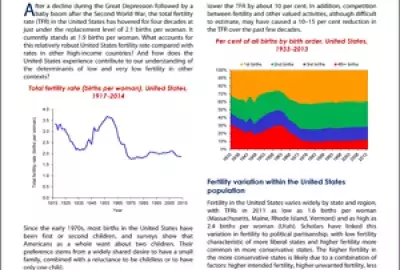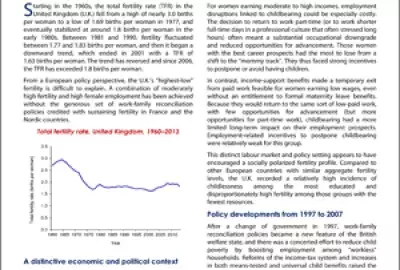Error message

In Norway, fertility began declining in the mid-1960s, driven by the strong expansion of education, especially for women, later and fewer marriages, and the wide acceptance of new contraceptive technologies. Norwegian fertility levels never fell below 1.6 births per woman, however, and have been fairly stable between 1.75 and 2.00 births per woman since around 1990. The total fertility rate over 2000-2013 period averaged 1.86 births per woman, not much below the "replacement level" of 2.08 births per woman.
Why has fertility in Norway remained at consistently higher levels than in most other developed countries? Norway's advantaged economic position is probably one reason. There is little income insecurity for individual families, and the State is generous with parents, not least with respect to daycare and parental leave arrangements that make it easier for parents to combine work and family responsibilities.
Widely shared liberal social values also probably play a role. Although there has been a massive retreat from marriage — including later marriage, a growing proportion who never marry and rising divorce rates — this has been compensated by a rise in informal cohabitation, and many cohabitants have children. In 2014, cohabiting mothers accounted for 44 per cent of all births, and single mothers accounted for an additional 13 per cent.
In Norway, fertility began declining in the mid-1960s, driven by the strong expansion of education, especially for women, later and fewer marriages, and the wide acceptance of new contraceptive technologies. Norwegian fertility levels never fell below 1.6 births per woman, however, and have been fairly stable between 1.75 and 2.00 births per woman since around 1990. The total fertility rate over 2000-2013 period averaged 1.86 births per woman, not much below the "replacement level" of 2.08 births per woman.
Why has fertility in Norway remained at consistently higher levels than in most other developed countries? Norway's advantaged economic position is probably one reason. There is little income insecurity for individual families, and the State is generous with parents, not least with respect to daycare and parental leave arrangements that make it easier for parents to combine work and family responsibilities.
Widely shared liberal social values also probably play a role. Although there has been a massive retreat from marriage — including later marriage, a growing proportion who never marry and rising divorce rates — this has been compensated by a rise in informal cohabitation, and many cohabitants have children. In 2014, cohabiting mothers accounted for 44 per cent of all births, and single mothers accounted for an additional 13 per cent.
Policy Briefs - United Nations Expert Group Meeting on Policy Responses to Low Fertility







